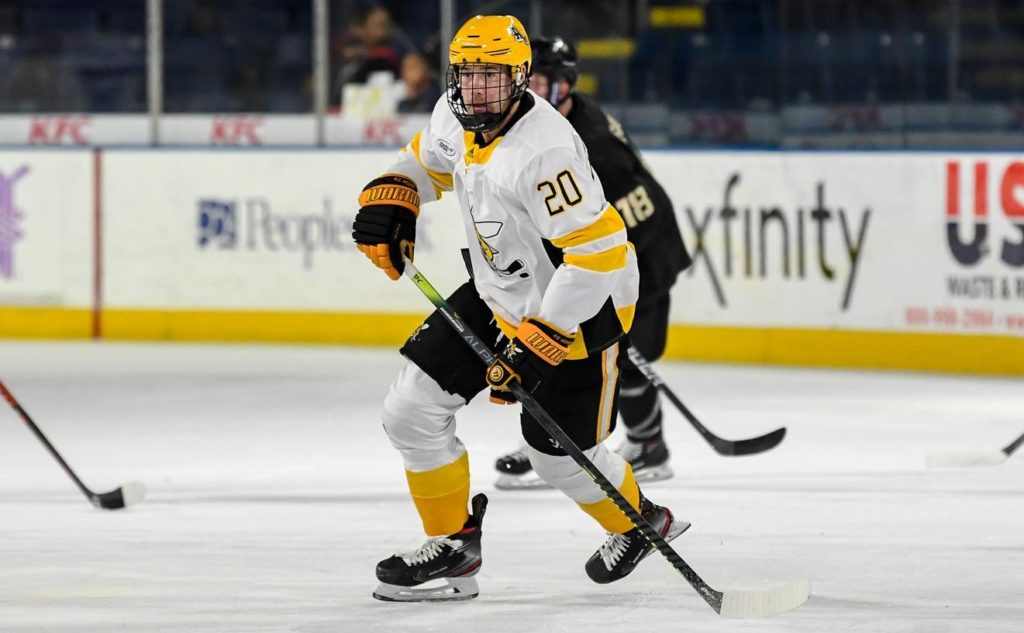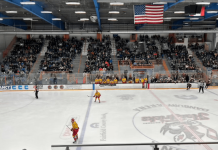
Each week during the season, we look at the big events and big games around Division I men’s college hockey in Tuesday Morning Quarterback.
Jim: Paula, as we write this on Monday, the NCHC pod has successfully concluded. And it did so with marked success.
There wasn’t a positive COVID case reported for anyone involved once they reached Omaha. After tweaking the schedule to accommodate Colorado College’s late arrival due to their COVID issues back on campus, every game was played on schedule. So first, my hat’s off to everyone involved top to bottom.
I was interested in what teams stood out. We all had visions of a strong North Dakota team and they delivered, particularly in the final week going 3-0. Minnesota Duluth, St. Cloud and Omaha were three other teams that impressed.
Then there is Denver. In this space two weeks ago, after the Pioneers began with three one-goal losses, we intimated maybe there should be some concern. Well, the Pioneers head back home with a 3-6-1 record and, based on winning percentage, sit sixth in the eight-team conference.
Is it time to really sound the alarm on Denver?
Paula: For several reasons, I think it is. Those close losses were a harbinger, and since then, the Pioneers have struggled to take games when games were within reach. While they’ve kept most games close, the Pioneers finish the first half with a 3-6-1 record with their other two wins over teams behind them in the standings, Western Michigan and Miami.
Denver has been outscored 28-23 through 10 games – again, close – but the Pioneers are middling in both offense (2.30 goals per game) and defense (2.80) with an okay power play and a not-so-okay PK.
I’m not clear why Denver’s time in the pod was so rough, but once again my thoughts turn to the relative strength of the NCHC – and that is another reason to sound the alarm on Denver. The top four teams in the conference look more than just very good, so Denver’s rocky start will be very difficult to overcome in the second half.
As you pointed out, the success of the Omaha pod is something to be commended. The thing that strikes me most about that experiment, though, is how absolutely normal it feels now to be talking about the NCHC as the dominant league as the first half of the season comes to a close.
Something else of note is how well the hometown team performed. The Mavericks had a total of eight conference wins last season. At the end of the first half, Omaha has five wins and is fourth in the conference.
Jim: I feel like Omaha is maybe the best story of the NCHC pod. I will be interested to see how things go when they return to on-campus play, but Omaha’s success can’t be ignored.
Another great story that far has been the play of AIC. The Yellow Jackets are now 5-0-0 after twice defeating Bentley. The Yellow Jackets have allowed exactly one goal in each of its five games. And thought the offense isn’t exactly firing on every cylinder, a 16-5 scoring margin will go a very long way.
There are a lot of teams we can brag about, but AIC seems poised to be the cream of the Atlantic Hockey crop.
Paula: It’s impossible to ignore how the Yellow Jackets have performed so far, establishing themselves as the team to catch in a conference that becomes increasingly more competitive every season. It’s nice, too, to see AIC garner recognition for that by cracking the USCHO poll.
Also impossible to ignore is the play of AIC senior goaltender Stefano Durante, with his .957 save percentage and 1.00 GAA in his four games. We know that a hot goaltender can carry a team through tough stretches, but that’s not what we’re seeing here from the Yellow Jackets. While not spectacularly deep in scoring, AIC is getting solid play up front from several players, especially from team scoring leader, senior Tobias Fladeby.
In the first five games of the season for AIC, Fladeby is a one-man wrecking crew: five goals, three of which are on the power play, two of which are shorthanded and two goals are game-winners. It took Fladeby a dozen games to score the first five of his 12 goals last season.
Robert Morris and Holy Cross have had strong starts, too, but if the Yellow Jackets return to conference play in January the way they began the season, they’ll make it difficult for anyone to catch them.
Jimmy, looking back on the first half, what are some of the other developments – or lack of developments – that have surprised you?
Jim: There is only one word that comes to mind for the “first half” (we’re not at the halfway point, but in most years we are), and that is “flexibility.”
Especially when it comes to leagues like Hockey East, the ECAC (remember, eight teams aren’t playing?!?), Atlantic Hockey and the WCHA. What was scheduled back in September or October, for the most part, doesn’t necessarily apply. Most weeks, coaches are calling other coaches on Mondays and Tuesdays to try to figure out if they can find an unscheduled game. There is a lot of labor put into finding ways to play games. At this point, Boston University and St. Lawrence still haven’t even played a single game. The Larries were ready to play this weekend only to have their game against Colgate canceled for COVID protocols
Personally, I guess I didn’t anticipate the season would begin with this many problems. So for me, that’s by far the biggest surprise. How about you?
Paula: My biggest surprise is the exact opposite of yours: I didn’t expect pre-holiday hockey to go this smoothly.
Given how well things went for the NBA and WNBA, I anticipated that the NCHC pod experiment would go well, but to hear that zero positive tests were reported is stunning to me. Kudos to the NCHC for the way they ran that pod, and I’m grateful that everyone involved was safe while they were there.
Given the amount of travel involved in the Big Ten and what I already knew about how the coronavirus was making its way through several Big Ten campuses prior to and during the weeks in which hockey was played, I am surprised by how little that schedule was disrupted. Again, kudos to everyone involved in making that happen – and mad props to the Sun Devils for their 36-day road trip to play B1G opponents. There is a lot that could have gone wrong there that did not.
The things you list about the problems that coaches and programs are encountering, all of the complications because of COVID-19, run the gamut from challenging to awful. No one wants to see anyone get sick. We still don’t know the long-term effects of the coronavirus on teens and younger adults, and there are plenty of at-risk people who work with hockey programs everywhere.
Yet we have four leagues that have done a remarkable job of getting hockey played before what would traditionally be the holiday break. Given the projections of what the coronavirus may do in the first months of the new year, this is something for which college hockey fans should be especially grateful.
I still remain skeptical about finishing what resembles a full season by April, but that has nothing to do with the NCAA, individual leagues or teams or anyone involved with D-I hockey. Vaccines are coming (thankfully!) but we simply don’t know what’s in store in the coming weeks and months.
And that is why my biggest takeaway from the first half is how relatively smoothly it all went during a global pandemic. I’m happy that so much interesting hockey was played and that we have compelling conference storylines to watch in the coming year. I’m especially happy for the players. It’s been a tough year for students of all ages.
Jimmy, here’s wishing all of our readers and everyone in the hockey community a healthy and happy 2021.

